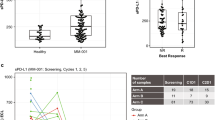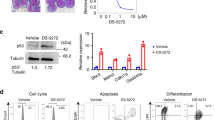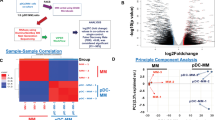Abstract
FTY720 (also called fingolimod) is recognized as an immunosuppressant and has been approved by the Food and Drug Administration to treat refractory multiple sclerosis. However, long-term administration of FTY720 potentially increases the risk for cancer in recipients. The underlying mechanisms remain poorly understood. Herein, we provided evidence that FTY720 administration potentiated tumor growth. Mechanistically, FTY720 enhanced extramedullary hematopoiesis and massive accumulation of myeloid-derived suppressor cells (MDSCs), which actively suppressed antitumor immune responses. Granulocyte–macrophage colony-stimulating factor (GM-CSF), mainly produced by MDSCs, was identified as a key factor to mediate these effects of FTY720 in tumor microenvironment. Furthermore, we showed that FTY720 triggers MDSCs to release GM-CSF via S1P receptor 3 (S1pr3) through Rho kinase and extracellular signal-regulated kinase-dependent pathway. Thus, our findings provide mechanistic explanation for the protumorigenic potentials of FTY720 and suggest that targeting S1pr3 simultaneously may be beneficial for the patients receiving FTY720 treatment.
This is a preview of subscription content, access via your institution
Access options
Subscribe to this journal
Receive 50 print issues and online access
$259.00 per year
only $5.18 per issue
Buy this article
- Purchase on Springer Link
- Instant access to full article PDF
Prices may be subject to local taxes which are calculated during checkout








Similar content being viewed by others
References
Cyster JG, Schwab SR . Sphingosine-1-phosphate and lymphocyte egress from lymphoid organs. Annu Rev Immunol 2012; 30: 69–94.
Pham TH, Okada T, Matloubian M, Lo CG, Cyster JG . S1p1 receptor signaling overrides retention mediated by g alpha i-coupled receptors to promote t cell egress. Immunity 2008; 28: 122–133.
Schwab SR, Cyster JG . Finding a way out: lymphocyte egress from lymphoid organs. Nat Immunol 2007; 8: 1295–1301.
Mandala S, Hajdu R, Bergstrom J, Quackenbush E, Xie J, Milligan J et al. Alteration of lymphocyte trafficking by sphingosine-1-phosphate receptor agonists. Science 2002; 296: 346–349.
Mullershausen F, Zecri F, Cetin C, Billich A, Guerini D, Seuwen K . Persistent signaling induced by fty720-phosphate is mediated by internalized s1p1 receptors. Nat Chem Biol 2009; 5: 428–434.
Oo ML, Thangada S, Wu MT, Liu CH, Macdonald TL, Lynch KR et al. Immunosuppressive and anti-angiogenic sphingosine 1-phosphate receptor-1 agonists induce ubiquitinylation and proteasomal degradation of the receptor. J Biol Chem 2007; 282: 9082–9089.
Cohen JA, Barkhof F, Comi G, Hartung HP, Khatri BO, Montalban X et al. Oral fingolimod or intramuscular interferon for relapsing multiple sclerosis. N Engl J Med 2010; 362: 402–415.
Calabresi PA, Radue EW, Goodin D, Jeffery D, Rammohan KW, Reder AT et al. Safety and efficacy of fingolimod in patients with relapsing-remitting multiple sclerosis (freedoms ii): a double-blind, randomised, placebo-controlled, phase 3 trial. Lancet Neurol 2014; 13: 545–556.
Conzett KB, Kolm I, Jelcic I, Kamarachev J, Dummer R, Braun R et al. Melanoma occurring during treatment with fingolimod for multiple sclerosis: a case report. Arch Dermatol 2011; 147: 991–992.
Ostrand-Rosenberg S, Sinha P . Myeloid-derived suppressor cells: Linking inflammation and cancer. J Immunol 2009; 182: 4499–4506.
Sio A, Chehal MK, Tsai K, Fan X, Roberts ME, Nelson BH et al. Dysregulated hematopoiesis caused by mammary cancer is associated with epigenetic changes and hox gene expression in hematopoietic cells. Cancer Res 2013; 73: 5892–5904.
Wu WC, Sun HW, Chen HT, Liang J, Yu XJ, Wu C et al. Circulating hematopoietic stem and progenitor cells are myeloid-biased in cancer patients. Proc Natl Acad Sci USA 2014; 111: 4221–4226.
Sevko A, Umansky V . Myeloid-derived suppressor cells interact with tumors in terms of myelopoiesis, tumorigenesis and immunosuppression: thick as thieves. J Cancer 2013; 4: 3–11.
Kim EK, Jeon I, Seo H, Park YJ, Song B, Lee KA et al. Tumor-derived osteopontin suppresses antitumor immunity by promoting extramedullary myelopoiesis. Cancer Res 2014; 74: 6705–6716.
Griseri T, McKenzie BS, Schiering C, Powrie F . Dysregulated hematopoietic stem and progenitor cell activity promotes interleukin-23-driven chronic intestinal inflammation. Immunity 2012; 37: 1116–1129.
Swirski FK, Nahrendorf M, Etzrodt M, Wildgruber M, Cortez-Retamozo V, Panizzi P et al. Identification of splenic reservoir monocytes and their deployment to inflammatory sites. Science 2009; 325: 612–616.
Cortez-Retamozo V, Etzrodt M, Newton A, Rauch J, Chudnovskiy A, Berger C et al. Origins of tumor-associated macrophages and neutrophils. Proc Natl Acad Sci USA 2012; 109: 2491–2496.
Gabrilovich DI, Nagaraj S . Myeloid-derived suppressor cells as regulators of the immune system. Nat Rev Immunol 2009; 9: 162–174.
Peranzoni E, Zilio S, Marigo I, Dolcetti L, Zanovello P, Mandruzzato S et al. Myeloid-derived suppressor cell heterogeneity and subset definition. Curr Opin Immunol 2010; 22: 238–244.
Kusmartsev S, Nefedova Y, Yoder D, Gabrilovich DI . Antigen-specific inhibition of cd8+ t cell response by immature myeloid cells in cancer is mediated by reactive oxygen species. J Immunol 2004; 172: 989–999.
Bronte V, Serafini P, De Santo C, Marigo I, Tosello V, Mazzoni A et al. Il-4-induced arginase 1 suppresses alloreactive T cells in tumor-bearing mice. J Immunol 2003; 170: 270–278.
Youn JI, Nagaraj S, Collazo M, Gabrilovich DI . Subsets of myeloid-derived suppressor cells in tumor-bearing mice. J Immunol 2008; 181: 5791–5802.
Condamine T, Gabrilovich DI . Molecular mechanisms regulating myeloid-derived suppressor cell differentiation and function. Trends Immunol 2011; 32: 19–25.
Lee TK, Man K, Ho JW, Wang XH, Poon RT, Xu Y et al. Fty720: A promising agent for treatment of metastatic hepatocellular carcinoma. Clin Cancer Res 2005; 11: 8458–8466.
Liu Q, Alinari L, Chen CS, Yan F, Dalton JT, Lapalombella R et al. Fty720 shows promising in vitro and in vivo preclinical activity by downmodulating cyclin d1 and phospho-akt in mantle cell lymphoma. Clin Cancer Res 2010; 16: 3182–3192.
Saddoughi SA, Gencer S, Peterson YK, Ward KE, Mukhopadhyay A, Oaks J et al. Sphingosine analogue drug fty720 targets i2pp2a/set and mediates lung tumour suppression via activation of pp2a-ripk1-dependent necroptosis. EMBO Mol Med 2013; 5: 105–121.
Pitman MR, Woodcock JM, Lopez AF, Pitson SM . Molecular targets of fty720 (fingolimod). Curr Mol Med 2012; 12: 1207–1219.
Collison A, Hatchwell L, Verrills N, Wark PA, de Siqueira AP, Tooze M et al. The e3 ubiquitin ligase midline 1 promotes allergen and rhinovirus-induced asthma by inhibiting protein phosphatase 2a activity. Nat Med 2013; 19: 232–237.
Bayne LJ, Beatty GL, Jhala N, Clark CE, Rhim AD, Stanger BZ et al. Tumor-derived granulocyte–macrophage colony-stimulating factor regulates myeloid inflammation and t cell immunity in pancreatic cancer. Cancer Cell 2012; 21: 822–835.
Pylayeva-Gupta Y, Lee KE, Hajdu CH, Miller G, Bar-Sagi D . Oncogenic kras-induced gm-csf production promotes the development of pancreatic neoplasia. Cancer Cell 2012; 21: 836–847.
Mendelson K, Evans T, Hla T . Sphingosine 1-phosphate signalling. Development 2014; 141: 5–9.
Janknecht R, Ernst WH, Pingoud V, Nordheim A . Activation of ternary complex factor elk-1 by map kinases. EMBO J 1993; 12: 5097–5104.
Hipskind RA, Rao VN, Mueller CG, Reddy ES, Nordheim A . Ets-related protein elk-1 is homologous to the c-fos regulatory factor p62tcf. Nature 1991; 354: 531–534.
Greten TF, Manns MP, Korangy F . Myeloid derived suppressor cells in human diseases. Int Immunopharmacol 2011; 11: 802–807.
Cohen JA, Chun J . Mechanisms of fingolimod's efficacy and adverse effects in multiple sclerosis. Ann Neurol 2011; 69: 759–777.
Yasui H, Hideshima T, Raje N, Roccaro AM, Shiraishi N, Kumar S et al. Fty720 induces apoptosis in multiple myeloma cells and overcomes drug resistance. Cancer Res 2005; 65: 7478–7484.
Hung JH, Lu YS, Wang YC, Ma YH, Wang DS, Kulp SK et al. Fty720 induces apoptosis in hepatocellular carcinoma cells through activation of protein kinase c delta signaling. Cancer Res 2008; 68: 1204–1212.
Matloubian M, Lo CG, Cinamon G, Lesneski MJ, Xu Y, Brinkmann V et al. Lymphocyte egress from thymus and peripheral lymphoid organs is dependent on s1p receptor 1. Nature 2004; 427: 355–360.
Marvel D, Gabrilovich DI . Myeloid-derived suppressor cells in the tumor microenvironment: expect the unexpected. J Clin Invest 2015; 125: 3356–3364.
Euvrard S, Kanitakis J, Claudy A . Skin cancers after organ transplantation. N Engl J Med 2003; 348: 1681–1691.
Ueha S, Shand FH, Matsushima K . Myeloid cell population dynamics in healthy and tumor-bearing mice. Int Immunopharmacol 2011; 11: 783–788.
Liu G, Bi Y, Wang R, Yang H, Zhang Y, Wang X et al. Targeting s1p1 receptor protects against murine immunological hepatic injury through myeloid-derived suppressor cells. J Immunol 2014; 192: 3068–3079.
Katoh H, Wang D, Daikoku T, Sun H, Dey SK, Dubois RN . Cxcr2-expressing myeloid-derived suppressor cells are essential to promote colitis-associated tumorigenesis. Cancer Cell 2013; 24: 631–644.
Lorvik KB, Bogen B, Corthay A . Fingolimod blocks immunosurveillance of myeloma and b-cell lymphoma resulting in cancer development in mice. Blood 2012; 119: 2176–2177.
Lee H, Deng J, Kujawski M, Yang C, Liu Y, Herrmann A et al. Stat3-induced s1pr1 expression is crucial for persistent stat3 activation in tumors. Nat Med 2010; 16: 1421–1428.
Martinez-Moczygemba M, Huston DP . Biology of common beta receptor-signaling cytokines: IL-3, IL-5, and GM-CSF. J Allergy Clin Immunol 2003; 112: 653–665; quiz 666.
Elkabets M, Ribeiro VS, Dinarello CA, Ostrand-Rosenberg S, Di Santo JP, Apte RN et al. Il-1beta regulates a novel myeloid-derived suppressor cell subset that impairs NK cell development and function. Eur J Immunol 2010; 40: 3347–3357.
Hoechst B, Voigtlaender T, Ormandy L, Gamrekelashvili J, Zhao F, Wedemeyer H et al. Myeloid derived suppressor cells inhibit natural killer cells in patients with hepatocellular carcinoma via the nkp30 receptor. Hepatology 2009; 50: 799–807.
Hait NC, Wise LE, Allegood JC, O'Brien M, Avni D, Reeves TM et al. Active, phosphorylated fingolimod inhibits histone deacetylases and facilitates fear extinction memory. Nat Neurosci 2014; 17: 971–980.
Quatromoni JG, Singhal S, Bhojnagarwala P, Hancock WW, Albelda SM, Eruslanov E . An optimized disaggregation method for human lung tumors that preserves the phenotype and function of the immune cells. J Leukocyte Biol 2015; 97: 201–209.
Acknowledgements
This work was supported by grants from the National Key Basic Research Program of China (2015CB553704, 2013CB530506), the National Natural Science Foundation of China (81672803, 81472647, 81272320), Beijing Natural Science Foundation (7132151), Service Industry Scientific Research of National Health and Family Planning Commission of China (2015SQ00192).
Author information
Authors and Affiliations
Corresponding authors
Ethics declarations
Competing interests
The authors declare no conflict of interest.
Additional information
Supplementary Information accompanies this paper on the Oncogene website
Supplementary information
Rights and permissions
About this article
Cite this article
Li, Y., Zhou, T., Wang, Y. et al. The protumorigenic potential of FTY720 by promoting extramedullary hematopoiesis and MDSC accumulation. Oncogene 36, 3760–3771 (2017). https://doi.org/10.1038/onc.2017.2
Received:
Revised:
Accepted:
Published:
Issue Date:
DOI: https://doi.org/10.1038/onc.2017.2
This article is cited by
-
The role of protein phosphatase 2A tau axis in traumatic brain injury therapy
Beni-Suef University Journal of Basic and Applied Sciences (2022)
-
Peripheral myeloid-derived suppressor cells are good biomarkers of the efficacy of fingolimod in multiple sclerosis
Journal of Neuroinflammation (2022)
-
New FTY720-docetaxel nanoparticle therapy overcomes FTY720-induced lymphopenia and inhibits metastatic breast tumour growth
Breast Cancer Research and Treatment (2017)



